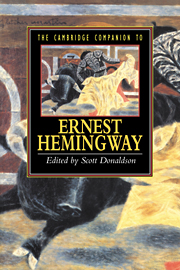Book contents
- Frontmatter
- 1 Introduction
- 2 Hemingway's journalism and the realist dilemma
- 3 1924
- 4 In Our Time, out of season
- 5 Brett and the other women in The Sun Also Rises
- 6 A Farewell to Arms
- 7 Hemingway's late fiction
- 8 Hemingway and politics
- 9 Hemingway and gender history
- 10 Hemingway, Hadley, and Paris
- 11 Hemingway's Spanish sensibility
- 12 The Cuban context of The Old Man and the Sea
- 13 Conclusion
- Selected Bibliography
- Index
- Series List
6 - A Farewell to Arms
Doctors in the house of love
Published online by Cambridge University Press: 28 May 2006
- Frontmatter
- 1 Introduction
- 2 Hemingway's journalism and the realist dilemma
- 3 1924
- 4 In Our Time, out of season
- 5 Brett and the other women in The Sun Also Rises
- 6 A Farewell to Arms
- 7 Hemingway's late fiction
- 8 Hemingway and politics
- 9 Hemingway and gender history
- 10 Hemingway, Hadley, and Paris
- 11 Hemingway's Spanish sensibility
- 12 The Cuban context of The Old Man and the Sea
- 13 Conclusion
- Selected Bibliography
- Index
- Series List
Summary
A text, as we are now almost too much aware, is never the same text twice. Words once translucent become opaque; issues once current become historical footnotes. The concerns of one generation are rejected by the next only to be rediscovered by their grandchildren in a different context. A century and a half ago Ralph Waldo Emerson told us that each generation has to write its own books. He might have added that each generation also has to reinterpret the books it has inherited from the past. A Farewell to Arms was written for the generation who experienced the Great European War that we now call World War I. The next generation of readers brought to the text its experience from World War II. We are now past the third generation with its Vietnam experience and well into postmodernist readings.
The first two generations of readers grew up with the public image of Hemingway engraved on their collective consciousness, a condition that encouraged misleading and frequently irrelevant biographical readings of Hemingway's fiction. The author opened his texts to such readings when he used recognizable prototypes from the Left Bank as characters in his first novel, The Sun Also Rises (1926). Afterwards it became an easy generalization to say that Hemingway wrote only about his own firsthand experiences and that his central male character was a thinly veiled self-portrait. This Hemingway Hero, like his creator, grew older as he engaged in the Hemingway interests: bullfighting, hunting, fishing, boxing, and war. That Hemingway never fought in the bullring, hunted African game only twice, never caught a giant marlin on a hand line, was never a professional boxer, and never served as a soldier in any capacity could not dissuade those readers who needed his actual life to be as exciting as his fictive world. That this need was real says more about the period and its readers than it does about the author and his texts.
- Type
- Chapter
- Information
- The Cambridge Companion to Hemingway , pp. 109 - 127Publisher: Cambridge University PressPrint publication year: 1996
- 2
- Cited by



